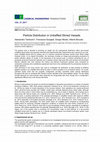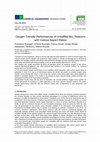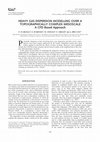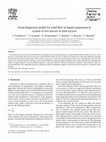Papers by Francesca Scargiali

Chemical Engineering Transactions, 2017
The present work is devoted to providing an insight into the solid-particle distribution within t... more The present work is devoted to providing an insight into the solid-particle distribution within top-covered unbaffled stirred tanks via purposely collected local experimental data. Experiments were carried out on a lab- scale unbaffled stirred tank by making use of a recently introduced technique named Laser Sheet Image Analysis (LSIA). In its original formulation, the technique includes an image post-processing procedure to delete reflection effects on results. In the framework of the present work, a method combining the use of purposely produced fluorescent particles and a suitable camera high pass filter was devised and presented. Results collected with (new method) and without (old fashion) fluorescent particles were compared for comparison purposes and a satisfactory agreement was found, thus validating both the procedures devised to delete reflections. LSIA technique in the novel version was used to investigate the distribution of solid particles at different agitation speeds ...
ABSTRACT For accurately measuring k(L)a in bioreactors the dynamic pressure method (DPM) was intr... more ABSTRACT For accurately measuring k(L)a in bioreactors the dynamic pressure method (DPM) was introduced by Linek et al. (1993). In this work a simplified version of the same method is discussed. With respect to the original DPM, the simplified version greatly simplifies data treatment. In fact final constant slope observable in the usual semi-log diagram of residual driving force versus time may be simply corrected to obtain the real k(L)a value with negligible inaccuracy. Experimental data obtained on a lab-size stirred tank reactor confirm all model predictions, including the feature that the adoption of large pressure changes may lead to a better accuracy.
There is a growing interest in using unbaffled stirred tanks for addressing certain processing ne... more There is a growing interest in using unbaffled stirred tanks for addressing certain processing needs. In this work, digital image analysis coupled with a suitable shadowgraphy-based technique is used to investigate the shape of the free-surface vortex that forms in uncovered unbaffled stirred tanks. The technique is based on back-lighting the vessel and suitably averaging vortex shape over time. Impeller clearance from vessel bottom and tank filling level are varied to investigate their influence on vortex shape. A correlation is finally proposed to fully describe vortex shape also when the vortex encompasses the impeller.

ABSTRACT Cultivation of microorganisms, plants or animal cells requires liquid agitation in order... more ABSTRACT Cultivation of microorganisms, plants or animal cells requires liquid agitation in order to ensure oxygen and nutrient transfer and to maintain cell suspension. However, in such suspensions both mechanical agitation and sparging aeration can cause cell death. Many studies on animal cell damage due to mechanical agitation and sparging aeration have shown that mechanical damage of freely suspended animal cells is in most cases associated with bursting bubbles at the air-liquid interface (Barrett et al., 2010; Nienow et al., 1996). Gas bubbles are usually generated by direct air sparging to propagate oxygen in a culture suspension. Mechanical agitation may also introduce gas bubbles to the culture fluid through vortexing entrainment from the free surface. In this work oxygen transfer performance of an unbaffled stirred vessel is presented in view of its use as biochemical reactor for animal cell growth. As a matter of fact, oxygen mass transfer can occur through the free surface deep vortex which takes place when agitation is started. If this is not allowed to reach impeller blades, bubble formation and subsequent bursting inside the reactor is avoided. Experimental results showed that this kind of bioreactor may well provide sufficient oxygen mass transfer for animal cell growth so resulting in a valid alternative to more common sparged reactors. Clearly this potential needs to be confirmed by in vivo experimentation, before firm conclusions are drawn.

Chemical Engineering Journal, 2014
ABSTRACT The present work is aimed at providing experimental information on mixing rates in an un... more ABSTRACT The present work is aimed at providing experimental information on mixing rates in an unbaffled vessel under free surface vortexing conditions. The planar laser induced fluorescence (PLIF) technique was used for measuring the dispersion dynamics of a passive tracer over a vertical section of the vessel. In agreement with the quite scant literature information available for these systems, results confirm the existence of two well defined, partially segregated, zones that give rise to a double mixing dynamics behavior. A suitable mixing time definition is proposed and applied to a number of experimental runs with different stirrer geometries and agitation speeds. Results confirm that unbaffled vessels are indeed poorer mixers than baffled tanks. In fact, when compared on the basis of same power input, i.e. in terms of mixing efficiency, mixing times are found to be 2-3 times larger than those pertaining to baffled tanks. However, in the 0.19 m diameter vessel employed, the observed mixing times typically fell in the range between 10 and 100 s, which makes them fully compatible with many applications involving relatively slow processes. Moreover, when free-surface vortex bottom approached the impeller plane, mixing efficiencies became practically identical to those of baffled tanks. This is a remarkable finding, as it considerably widens the potential application field of unbaffled vessels.
Chemical Engineering & Technology, 2014
ABSTRACT Bubble formation at variously inclined submerged nozzles, fed with a continuous gas flow... more ABSTRACT Bubble formation at variously inclined submerged nozzles, fed with a continuous gas flow rate, is investigated. The average liquid velocity induced by bubble motion is determined, leading to a simple correlation for estimation of the liquid velocities induced by the repeated passage of bubbles. An effective model for the prediction of bubble sizes at their detachment from vertical nozzle orifices is presented which encompasses a bound expansion stage, followed by an accelerated expansion phase, and ends by an original bubble detachment criterion. The existence of a liquid-phase effective entrainment velocity, generated by the continuous passage of the bubble stream, is quantified and included in the model. Model predictions are found to correlate well with experimental and literature data.

Industrial & Engineering Chemistry Research, 2014
ABSTRACT Particle suspension in liquids is a unit operation commonly encountered in the process i... more ABSTRACT Particle suspension in liquids is a unit operation commonly encountered in the process industry. Although it is usually carried out in baffled stirred tanks, there are some specific applications where the presence of baffles may be undesirable. In the present work solid–liquid suspensions are investigated in a radially stirred unbaffled tank provided with a top cover. The minimum impeller speed at which all solid particles get suspended (Njs) and the relevant power requirements (Pjs) are assessed. The dependence of these two parameters on physical properties (liquid viscosity, particle concentration, and size) and system geometrical configurations (impeller diameter and clearance) is investigated, and a correlation for the Njs estimation is proposed. Results mark some notable differences with respect to baffled tanks: Njs appears to be almost independent of particle diameter, a feature that may suggest the adoption of unbaffled tanks when large heavy particles are to be dealt with. Also, Njs was found to decrease as liquid viscosity increases, once again marking a favorable discrepancy with respect to baffled vessels. As concerns the system geometrical configuration, a tank stirred by a D = T/3 six-bladed Rushton turbine offset by T/3 from the tank bottom is found to be the most convenient configuration among those investigated in this work. Present results are finally compared with literature information on solids suspension in baffled or unsteadily agitated unbaffled systems. In both cases, top-covered unbaffled stirred vessels are found to be a convenient choice, provided that mixing times are not a controlling factor.

Chemical Engineering Tranactions, 2014
Cultivation of microorganisms, plants or animal cells requires liquid agitation in order to ensur... more Cultivation of microorganisms, plants or animal cells requires liquid agitation in order to ensure oxygen and nutrient transfer and to maintain cell suspension. Many studies on animal cell damage due to mechanical agitation and sparging aeration have shown that mechanical damage of freely suspended animal cells is in most cases associated with bursting bubbles at the air-liquid interface (Barrett et al., 2010). Gas bubbles are usually generated by direct air sparging aimed at supplying oxygen to the culture medium. Mechanical agitation may also introduce gas bubbles in the culture medium via vortexing entrainment from the free surface. In this work oxygen transfer performance of an unbaffled stirred bioreactor, with various aspect ratios, is presented in view of its use as a biochemical reactor for animal cell growth. In practice oxygen mass transfer occurs through the (more or less deep) free surface vortex which takes place when agitation is started in unbaffled vessels. If this vortex is not allowed to reach impeller blades, bubble formation and subsequent bursting at the free-surface is avoided. Experimental results show that this kind of bioreactor can provide sufficient oxygen mass transfer for animal cell growth, so resulting in a viable alternative to the more common sparged reactors. The masstransfer performance observed with the different aspect ratio configurations is also presented and discussed.

Process Safety and Environmental Protection, 2005
P otentially dangerous events involving heavy gas dispersion and their severe consequences have b... more P otentially dangerous events involving heavy gas dispersion and their severe consequences have been largely publicized by the media. Simplified models have been widely applied to describe the effects of these accidents. However, most simplified models deal with flat terrain scenarios and are based on quite crude simplifications of the complex phenomenology involved. In this paper the possibility of simulating the dispersion of heavy gas clouds over a large topographically complex area (tens of km) by a general purpose computational fluid dynamics (CFD) code is investigated. The aim is that of setting up a tool able to produce a realistic description of such dispersion processes, whose results can be useful in considering the question of when and by how much one can be misled by a simplified model. The paper is divided in two parts: the first part describes the use of CFD simulations to generate the micrometeorological parameters which characterize the site before the release of the toxic material, while the second part deals with the dispersion process itself. The geographical region examined is the industrial site of Priolo-Gargallo/Augusta in the eastern part of Sicily, covering an extension of 30 Â 30 km 2 .

Journal of Hazardous Materials, 2011
The formation of toxic heavy clouds as a result of sudden accidental releases from mobile contain... more The formation of toxic heavy clouds as a result of sudden accidental releases from mobile containers, such as road tankers or railway tank cars, may occur inside urban areas so the problem arises of their consequences evaluation. Due to the semi-confined nature of the dispersion site simplified models may often be inappropriate. As an alternative, computational fluid dynamics (CFD) has the potential to provide realistic simulations even for geometrically complex scenarios since the heavy gas dispersion process is described by basic conservation equations with a reduced number of approximations. In the present work a commercial general purpose CFD code (CFX 4.4 by Ansys ®) is employed for the simulation of dense cloud dispersion in urban areas. The simulation strategy proposed involves a stationary pre-release flow field simulation followed by a dynamic after-release flow and concentration field simulations. In order to try a generalization of results, the computational domain is modeled as a simple network of straight roads with regularly distributed blocks mimicking the buildings. Results show that the presence of buildings lower concentration maxima and enlarge the side spread of the cloud. Dispersion dynamics is also found to be strongly affected by the quantity of heavy-gas released.

Industrial & Engineering Chemistry Research, 2013
ABSTRACT Notwithstanding the increasing industrial interest toward unbaffled tanks, available exp... more ABSTRACT Notwithstanding the increasing industrial interest toward unbaffled tanks, available experimental information on their behavior is still scant, even for basic quantities such as the mechanical power drawn. In this work, the influence of the Reynolds and Froude numbers on the power consumption characteristics is presented for unbaffled stirred tanks operating both in nonaerated conditions (subcritical regime) and in aerated conditions (supercritical regime), i.e., when the free surface vortex has reached the impeller and the gas phase is ingested and dispersed inside the reactor. Experimental results obtained at various liquid viscosities show that power numbers obtained in subcritical conditions do line up quite well on a smooth Np versus Re function, with no need to involve the Froude number in the correlation. At rotational speeds involving air entrapment and dispersion inside the reactor (supercritical regime), a steep reduction of the power number is observed. A novel overall correlation for power number prediction, able to deal with both the subcritical and supercritical regimes, is finally proposed.

Chemical Engineering Science, 2013
ABSTRACT There is a growing interest in using unbaffled stirred tanks for addressing a number of ... more ABSTRACT There is a growing interest in using unbaffled stirred tanks for addressing a number of processing needs such as low shear damage (sensitive biocultures), low attrition (solid-liquid applications), deep-cleaning/sterilization (pharmaceutical applications). The main feature of uncovered, unbaffled stirred tanks is highly swirling motion of the fluid that results in a deformation of the free liquid surface. At sufficiently high agitation speeds the resulting whirlpool reaches the impeller and gives rise to a gas-liquid dispersion, so leading to the formation of a dispersion without the use of gas-sparger; the so-called self-inducing operation of the vessel. In this work, digital image analysis coupled with a suitable shadowgraphy-based technique is used to investigate the shape of the free-surface that forms in uncovered unbaffled stirred tanks, when different stirrer geometries are considered. The technique is based on back-lighting the vessel and suitably averaging over time the recorded free surface shape. For each investigated geometry, the deformed free-surface was analyzed at different impeller speeds. Different geometries of the vessel were analyzed, by varying impeller distance from vessel bottom as well as agitator type (Rushton turbine, Lightnin A310, Pitched Blade Turbine). It is shown that impeller design strongly affects the free surface profile, and in turn the impeller speed at which the free surface reaches the impeller. A model was developed to fully describe free-surface profile at all agitation speeds and for all investigated geometries, suitable for being adapted to experiments by means of physically consistent parameters adjustment.
Chemical Engineering Science, 2013
ABSTRACT In thisworkanovelexperimentaltechniqueformeasuringlocalgashold-up,interfacialareaandbubb... more ABSTRACT In thisworkanovelexperimentaltechniqueformeasuringlocalgashold-up,interfacialareaandbubble size distribution,ingas–liquidsystemsisproposed.ThetechniqueisbasedonadvancedImage Processing coupledwithexperimentalset-upstypicallyavailableforParticleImageVelocimetry. A fluorescent dyedissolvedintheliquidphaseallowstoidentify in-plane bubbles amongallvisible bubbles intheimages.Tothisend,asuitablealgorithmisproposed.Therawdatasoobtainedare processed bypreviouslydevelopedstatisticalmethodsthatresultinareliablereconstructionofactual dispersion properties. The techniqueisappliedtothecaseofagas-dispersedmechanicallyagitatedvessel,andthedata obtained arepresentedanddiscussed.
Chemical Engineering Science, 2010
Unbaffled stirred tanks are seldom employed in the process industry as they are considered poorer... more Unbaffled stirred tanks are seldom employed in the process industry as they are considered poorer mixers than baffled vessels. However, they may be expected to provide significant advantages in a wide range of applications (e.g. crystallization, food and pharmaceutical processes, etc.), where the presence of baffles is often undesirable. In the present work solid–liquid suspension in an unbaffled stirred tank
Chemical Engineering Science, 2010
Particle image velocimetry techniques coupled with advanced image processing tools are receiving ... more Particle image velocimetry techniques coupled with advanced image processing tools are receiving an increasing interest for measuring flow quantities and local bubble-size distributions in gas-liquid contactors. Aim of this work is that of providing a numerical procedure able to reconstruct local gas holdup and specific interfacial area from images obtained by laser sheet illumination. A correction for measured quantities accounting for laser sheet thickness is proposed and tested by means of Monte Carlo simulations. The algorithms proposed are robust and independent of any measured parameters of the actual bubble size distribution.

Chemical Engineering Research and Design, 2007
Computational fuid dynamics (CFD) is an increasingly important tool for carrying out realistic si... more Computational fuid dynamics (CFD) is an increasingly important tool for carrying out realistic simulations of process equipment. In the case of multiphase systems the development of CFD models is less advanced than for single-phase systems. In the present work CFD simulations of gas-liquid stirred tanks are reported. An Eulerian-Eulerian multi-fluid approach is used in conjunction with the simplest two-phase extension of the k-1 turbulence model. All bubbles are assumed to share the same size. The effect of inter-phase forces on simulation results is separately considered. As concerns drag, it is shown that the sole parameter needed to characterize the dispersed phase behaviour is bubble terminal velocity, a consideration that eases the estimation of the relevant term in the momentum equations and helps understanding the system physics. Despite the many simplifications adopted, results are found to be in satisfactory agreement with experiment.

Chemical Engineering Journal, 2006
The measurement of residence time distribution of solid particles in solid-liquid suspension is e... more The measurement of residence time distribution of solid particles in solid-liquid suspension is experimentally difficult. However, the twin system approach is particularly suited for the assessment of particle RTD in flow systems as it allows overcoming some of the usual difficulties generally encountered in this kind of measurement. Twin system consists of two vessels and external piping in total recycle. Experimental results from this system can be evaluated using Z-transforms to derive particle RTD for subsequent testing of alternative flow models. Recently, the axial dispersion model was applied using the "advection diffusion equation" (sometimes called the "diffusion with bulk flow equation") derived thereof, which was solved numerically. This contribution presents an analytical solution of analogous equations, which enables direct and precise evaluations of this problem.

Chemical Engineering Communications, 1992
ABSTRACT In this paper experimental information on the retention time distribution (RTD) of solid... more ABSTRACT In this paper experimental information on the retention time distribution (RTD) of solid particles in a high-aspect-ratio vessel, stirred by three equally spaced Rushton turbines, is presented. The relevant data were obtained by a special technique named twin system approach (TSA) that greatly simplifies the handling of particle-laden streams and is therefore particularly suited for investigating particle RTD in flow systems. The technique fundamentals are first summarized, together with the data analysis procedure. This lastly requires a numerical deconvolution operation that is easily performed with the help of Z-transforms. Two different approaches for excluding the spurious contributions of the external piping required for the experimentation are tested and discussed.Particle tracing was performed by an effective particle-coating/optical-detection technique that allows particles recovery and reuse after each experimental run.The RTD data obtained indicate that a cascade of ideally mixed tanks with backflow results into very good agreement with experiment, with practically any number of tanks in series but one, provided that the backflow rate parameter is chosen accordingly. In all cases, the recirculation is large enough for the resulting flow model to be quite close to a single perfectly stirred vessel.

Chemical Engineering & Technology, 2004
Despite its importance, experimental information on the Residence Time Distribution (RTD) of soli... more Despite its importance, experimental information on the Residence Time Distribution (RTD) of solid particles in continuousflow stirred vessels is still scant. In this work, experimental data on particle RTD in a high-aspect-ratio vessel stirred by three equally-spaced Rushton turbines, obtained by means of Twin Systems Approach (TSA), are employed to assess the suitability of the well known Axial-Dispersion Model to describe particle behavior in the investigated system. The data analysis and model parameter assessment are preceded by a discussion on the utility of self-recirculated systems in carrying out experiments concerning continuous slurry-fed apparatuses. In particular, the suitability of single recirculated systems is discussed and a way to extract numerical RTD data from the relevant experiments is proposed. The advantages and disadvantages of employing instead a couple of twin systems, as it was actually done to obtain the experimental data employed in this work, is shortly discussed.

Uploads
Papers by Francesca Scargiali